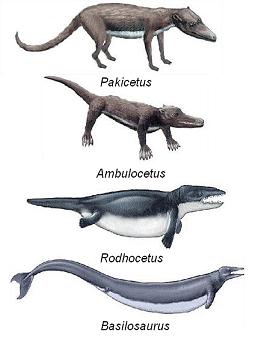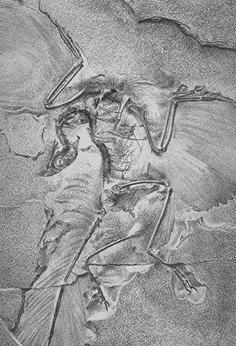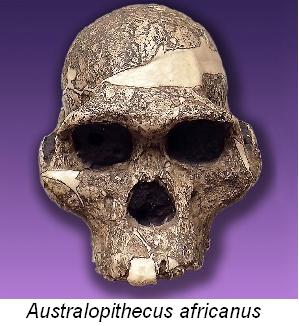
A lot of people look to the fossil record for evidence of evolution. This is reasonable, if all the species we see today are connected by intermediates there should be some evidence of them in the fossil record. Unfortunately the fossil record is quite incomplete, but even so we have many examples of fossil intermediates which link two groups. We discuss three examples below, the fish-tetrapod transition, the dinosaur-bird transition, and the evolution of humans. These transitions are supported by both fossil and DNA evidence. These examples were chosen as the groups involved are very familiar. But there are many more examples of intermediates connecting distant groups of both animals and plants.
Fish Fingers: The Fish-Tetrapod Transition
The earliest fossil fish date back to the Cambrian period, 600 million years ago. About 360 million years ago in the Devonian period, the first tetrapods evolved; they would have looked a bit like amphibians. Tetrapods are vertebrates which have four limbs. Living tetrapod groups include amphibians, reptiles, birds and mammals. All these groups of animals share ancestry with bony fish. Modern bony fish are divided up into two groups: the ray-finned fish are the more common of the two; the second group are the lobe-fin fish which are much less familiar. Few lobe-finned fish species exist today; living members include the coelacanth and lungfishes.
Lobe-finned fish have paired fins which contain many of the same bones, in the same position as those found in living tetrapods. Shared features suggested to biologists that tetrapods are closely related to these fish. If they are we might expect to find fossils of organisms that look a bit like a fish and a bit like a tetrapod, so do we?
Yes! Many spectacular fossils have been unearthed in the last few decades which show varying degrees of similarity to the two groups. For example, Eusthenopteron is a fossil dating back to around 385 million years ago. It looks very much like a fish, but shares some similar anatomical details with tetrapods including internal nostrils, and fore-fins with a humerus, ulna and radius, and hind-fins with a femur, tibia and fibula. These are the same bone structures as in our own limbs.

Move through the fossil record to 365 million years ago and we find Acanthostega discovered in 1987 by Prof. Jenny Clack who works in the Cambridge Zoology Department. Although its limbs look very tetrapod-like (and even have webbed fingers and toes!) Acanthostega probably lived in shallow swamps and may have used its limbs to paddle along, rather than for swimming or walking. It neither had a rib cage strong enough for terrestrial life, nor did it have wrist joints necessary for supporting its weight.

In rocks of about the same age we find Tiktaalik which was not discovered until 2006! Tiktaalik still looks quite a bit like a fish, but it is distinctly more tetrapod-like than Eusthenopteron. It even has anatomical details that suggest it could drag itself onto land. Instead of a stocky fin-like front limb Tiktaalik had a primitive wrist joint, allowing it’s front limbs to bear the animal’s weight. It also had a stronger rib cage, which is necessary for a terrestrial vertebrate which doesn’t have the buoyancy of water to help support its weight. The fossil even shows evidence of a neck joint, suggesting it could move its head without moving its body.
Only slightly later in fossil record a creature which looks more amphibian than fish appears. Ichthyostega was about 5 feet long, with joints in both pairs of limbs which suggest it could fully support its weight. The rib cage is big and strong suggesting it could breathe out of water. Prof. Clack has studied these fossils too, concluding Ichthyostega was partially terrestrial, perhaps only coming to land to sunbathe and warm up it's body temperature! It probably still needed to return to the water to find food and reproduce.
Towards the end of the Devonian period (about 360 million years ago) we find true terrestrial tetrapods such as Hynerpeton,Greerpeton and Tulerpeton. These animals looked very much like big salamanders, with limbs able to support their weight and drive locomotion, ribcages strong enough to prevent the lungs collapsing, and neck joints which increased the mobility of the head.
We’ve only presented a few of the fossils which link fish to tetrapods; there are many more making this transition one of the most well documented in the fossil record. We probably have so many good fossils of these animals because they lived in shallow, muddy, poorly oxygenated swamps – the ideal environment for fossilisation to take place. What drove the evolution of tetrapods? Well, at about the same time plants were colonising the land, their roots would have stabilised the earth around the water’s edge and provided food and new habitats for things like insects to leave the water. Once that happened there would have been lots of food for any creature that made it on land – strong selection favouring the evolution of tetrapods.
Back To The Sea
Tetrapods have also returned to aquatic lifestyles; there are aquatic snakes, semi aquatic lizards and even aquatic mammals, for example whales and dolphins. Whales and dolphins form a group of mammals called cetaceans which are most closely related to hippopotami! Cetaceans evolved from terrestrial animals that looked a bit like dogs about 60 million years ago. This transition is documented by fossils such as Pakicetus, Ambulocetus, Rhodocetus andBasilosaurus. Pakicetus is clearly adapted for swimming, but still quite dog-like in looks, whilst Basilosaurus looks pretty much like a whale with a bit of a dog-like head (it was also 18meters long!).

Prof. Jenny Clack, a paleobiologist at Cambridge, has worked for many years on this transition and continues to do so. You can read more about her and her work here. She has also written a book about the evolution of tetrapods called Gaining Ground: the origin and evolution of tetrapods (2002). This book and her research earned Prof. Clack the Daniel Giraud Elliot Medal awarded only every 4 years by the National Academy of Sciences!
You can watch BBC’s Horizon programme, which features Prof Clack, on YouTube in five parts. You can also listen to the Tiktaalik song.
Dino-Flight: The Dinosaur-Bird Transition
One of the most successful groups of tetrapods has been the birds. Like many other animals they appear so well suited to their way of life it's difficult to imagine how they evolved. But like all species they did. How do we know? The first clues come from looking at bird’s bones. They are clearly very similar to the bones found in lizards, reptiles and mammals. All these groups are tetrapods and all modern tetrapods share a particular feature called the pentadactyl limb. A Pentadactyl limb is just one that has five digits on the end, like our fingers. Although they are highly modified, we can identify the same five digits in a bird’s wing as we can in a lizard’s foot or a human hand. The bird's bones were most similar to those of reptiles, so biologists strongly suspected birds were closely related to them.
One group of reptiles in particular looked a good bet, the dinosaurs, and the fossil evidence backs up this conclusion. Yes, T-rex and all his mates are represented today by the likes of finches, tits and flamingos. Birds started to evolve from some ancestral dinosaur about 147 million years ago, at the end of the Jurrassic period.

The most famous fossil from this transition is Archaeopteryx. The skeleton clearly shows several features characteristic of birds; a wishbone, a reversed perching toe on the hind foot, and of course feathers. But it also shows features characteristic of dinosaurs; its bones match up and it has sharp teeth, its skull is pretty dinosaur like too, and it had a tail.

Archaeopteryx isn’t the only member of this transition.Sinosauropteryx a small, fast running dinosaur had a downy, feather-like covering on its back which possibly evolved as insulation; dinosaurs were probably cold blooded so young and small animals would have lost heat quickly. There are still others, like Protarchaeopteryx which had a feathery tail andCaudipteryx which had feathered arms and seems to have eaten stones to help digestion, just like a chicken. Then there are species like Sinornithosaurus, which was covered in feathers. There are fossils too of more bird-like animals; Confuciusornishad wings, a shortened tail and an early beak and lived about 120 million years ago.
Currently biologists believe feathers may have originally evolved to help keep the animal warm, and they may also have been used in signalling. Early Dino-Birds may have had brightly coloured feathers which they would have used to attract a mate, just like a peacock.
The fossils mentioned above, and others, suggest that birds evolved the ability to take flight from the ground. Early species may have been fast runners and used their feathered forelimbs to help them glide; over time powered flight evolved. In contrast, the evolution of flight in bats is thought to have begun by early species being gliders – throwing themselves out of trees and using skin flaps like parachutes.
Go Ape: The Descent Of Man
Many people see this as a controversial subject, but the evolution of humans from an ape ancestor is supported by DNA and fossil evidence. One major misunderstanding people commonly make (especially anti-evolutionists) is that humans evolved from chimpanzees. That’s not true. Chimpanzees are the closest living relative to humans, but since the time of our last common ancestor with chimps (about 5-7 million years ago) both humans and chimps have followed their own unique evolutionary paths. The last common ancestor of humans and chimps was an ape, but not a living one. Think about it like a family tree: next to you on your family tree are your siblings. Saying that humans evolved from chimpanzees is like saying your siblings are your parents. You and your brother or sister share a common ancestor (your parents) in the same way humans and chimpanzees share a common ancestor (an extinct ape).
Since the evolutionary history of humans and chimpanzees split, about 5-7 million years ago, many species of early humans (or hominins) have lived. In fact we have fossil evidence for over 20 species of hominins! The human fossil record is pretty good, partly due to human evolution being so recent, and partly because early humans often took shelter in dry, dark caves – good conditions for preserving bones. Anthropologists disagree with the exact relatedness of all these species, they certainly don’t form a straight line. Instead, there a lots of branches of related species; one of which eventually led to us. Other branches show that hominin evolution went down different routes. For example some species from the hominin genus Paranthropus were a lot stockier than other humans and the males were often a lot larger than the females, a bit like gorillas. Recently a new skeleton was found in Flores, Indonesia. It dates back to about 18,000 years ago so our own species was around already. The skeleton is very small suggesting an adult body size of about 20kg: a real life hobbit! Some scientists think this skeleton is a new species, they call itHomo floresiensis, others though think it’s a diseased Homo sapiens.

From the fossil record we can track the evolution of a number of traits associated with humans. For example humans have a flat face compared to apes, we walk upright, and of course we have pretty huge brains. Human evolution is often portrayed as a gradual progression, in fact the fossil record tells us otherwise. Bipedalism was quite an early adaptation,Australopithecus afarensis was bipedal around 4 million years ago. The reduction in face protrusion was more gradual, A. afarensis had quite a protruding face, Homo ergaster (2 million years ago) less so, H. erectus (1 million years ago) even less so.
The evolution of the human brain wasn’t evenly paced. The increase in brain volume didn’t really take off until around 2 million years ago around the time of the likes of H. rudolfensis, H.habilis, and H. ergaster. Brain size reached its maximum volume in (no not us) Homo neanderthalensis!
We also have evidence for the evolution of tool use, from rudimentary tools which are really just stones, to sharpened and shaped stone tools which require skill to make, through to early metal tools and more complex multi-part equipment.
Modern studies of human evolution can make use of DNA. The complete genomes of humans, chimps and several other primates have been sequenced. They provide the ultimate proof of our relatedness to apes and other primates; you have probably heard our genomes are about 96% identical to chimps. A major aim of researchers now is to compare these genomes to find out what bits of our genomes make humans what they are. Scientists in Germany have even managed to sequence bits of the genome of one of our more recent relatives Homo neanderthalensis! This raises the possibility of comparing our DNA with Neanderthals to find changes unique to our own species.
Cambridge has very good undergraduate courses on human evolution; you can read about studying biological anthropology here. A few years ago a new centre was set up for researchers studying human evolution. The Leverhulme Centre has scientists working on all sorts of different aspects of human evolution; including studies on primate behaviour, the culture and cognition of early humans, hominin morphology and development, and evolutionary genetics. You can read more about the centre here.
Written by Stephen Montgomery
References & Further Reading
At the Water's Edge
by Carl Zimmer, Touchstone: 1998
Dino-Birds
by Angela Milner, The Natural History Museum: 2002
Evolution: What the Fossils Say and Why it Matters
by Donald Prothero, Columbia University Press: 2007
Gaining Ground
by Jennifer Clack, Indiana University Press: 2002
The Human Story: Where We Come from and How we Evolved
by Charles Lockwood, Natural History Museum: 2007
Principles of Human Evolution
by Roger Lewin & Robert Foley, Wiley Blackwell: 2003
Taking Wing
by Pat Shipman, Weidenfeld & Nicolson: 1998
Your Inner Fish
by Neil Shubin, Penguin: 2009